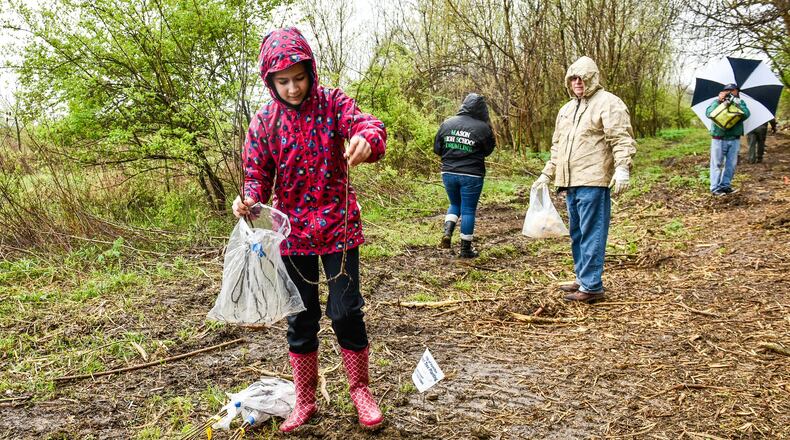For the past three years, Troy and Kathy Schwable have led a platoon of volunteers to improve the natural area, by mowing trails that had fallen into disrepair, and planting about 400 native trees. They’ve also spread the the word about the place, located in the city’s Lindenwald neighborhood.
The area, located along the Great Miami River next to Hamilton’s wastewater treatment plant (2451 River Road) is becoming something of a legend among birders.
One day, Riverside supporters were hosting the Cincinnati chapter of the National Audubon Society, who were hoping to a variety of birds, including the black-capped night heron.
“We were standing right next to a tree, and a lady’s asking me, ‘Do you think we’ll see one today?’” Troy said.
He asked her: “You mean like that one right there?”
Where he pointed, as if on cue, was just such a bird, “And he’s just standing there,” Troy said, with a chuckle.
“They went gaga over it,” Kathy said.
The Riverside Natural Area has won praise from the Ohio Prairie Association and the Audubon Society of Ohio, whose website says, “Despite the interesting mix of diverse habitats, Riverside Natural Area isn’t very well known among local birders. Hopefully that won’t last for long!”
“People didn’t know it was here,” Troy said. “Police officers didn’t know it was here.”
The Great Miami River itself, just feet away, has recovered a lot since the days when it would be green, blue or red, depending on what color Champion Paper was dying its products on that day. Proponents of tourism along 99 miles of the river envision a time when people will canoe or kayak it from Sidney to Hamilton, camping or staying in hotels along the way.
RELATED: The Great Miami River could be the next big destination in the region. Here’s why
“Out of Ohio’s total 405 bird species that have been sighted, including one-time sightings and some birds that have become extinct, the Riverside Natural Area has 197 of them, right here,” Troy said.
Among them are bald eagles, including some young ones the couple hope will make the area their permanent home.
On Tuesday morning, the couple led about 20 people in planting five species of native trees in a drizzle. It’s that kind of commitment that on Thursday led to the couple being named Hamilton’s Volunteers of the Year.
“They work really hard to get it all together,” said Karen Wittmer, the city’s program coordinator for volunteers, who said the pair “work like crazy” and are at the natural area pretty much every day.
Kathy Schwable showed off a beaver dam that recently was devastated by heavy river flooding. The beavers had it rebuilt within 48 hours, she said proudly.
Both Kathy and Troy have earned their Ohio Certified Volunteer Naturalist certificates. They began mowing the trails — an activity that had stopped years earlier because of city budget cuts — “and one thing led to another,” Kathy said. Three Boy Scout Eagle projects have further improved the park, and the couple are looking for other scouts to continue such projects.
American Heritage Girls also did a Stars and Stripes project that replaced seven boxes that will serve as homes to bats, and built nesting platforms that will be used by birds of prey.
Jackson Lanich, 13, and his sister, Addison Lanich, 12, helped plant trees in the natural area this week. Afterward, Addison said she was glad to have helped. Her brother said, “It makes me feel like a better person.”
The couple listed numerous people who have helped them, including city department heads, Hamilton’s parks conservancy, even a chemist at the sewage-treatment plant who helps clean up trash. Their organization, the Hamilton Conservation Corps, is funded completely from grants, foundations and donations.
“Our goal is, everybody knows what Mike Dingeldein and his group have done with CORE (Consortium for Ongoing Reinvestment Effort) Fund” in revitalizing downtown buildings, Troy said. “Our goal is to do the same thing with the nature areas.”
The area is an incredibly valuable gem for a city, Troy and Kathy believe.
“Cities of Hamilton’s size, they may have a one- or two-acre little glade of trees,” Troy said. “This is 200 acres. I’ve done searches on the Internet and looking through library catalogs, and to the best of my ability, there is no city-owned park that is a nature preserve — not a city park where there are baseball diamonds — inside a city that is this size.”
Unlike Central Park, Hamilton’s is purely a nature preserve, with no sports fields or zoo to interrupt the nature. Also, “New York City is like 332 square miles, and Hamilton is 22 square miles,” he said.
“And they don’t have beaver” in Central Park, he added. “And they don’t have free-flying bald eagles.”
About the Author
